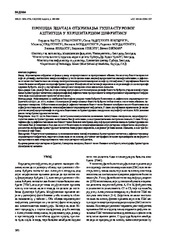Приказ основних података о документу
The significance of Goodpasture antigen in hereditary nephritis
| dc.creator | Basta-Jovanović, Gordana | |
| dc.creator | Radojević-Škodrić, Sanja | |
| dc.creator | Jovanović, M. | |
| dc.creator | Bogdanović, L. | |
| dc.creator | Bogdanović, R. | |
| dc.creator | Ležaić, Višnja | |
| dc.creator | Nesić, V. | |
| dc.creator | Dikman, S. | |
| dc.date.accessioned | 2020-07-02T12:17:45Z | |
| dc.date.available | 2020-07-02T12:17:45Z | |
| dc.date.issued | 2008 | |
| dc.identifier.issn | 0370-8179 | |
| dc.identifier.uri | https://smile.stomf.bg.ac.rs/handle/123456789/1393 | |
| dc.description.abstract | INTRODUCTION: Two types of hereditary nephritis, nonprogressive and progressive, clinically present as asymptomatic haematuria, sometimes combined with proteinuria. At the onset, in both types, light microscopic changes are minimal, immunofluorescence findings are negative, and diagnosis can be made only upon electron microscopic findings that are considered to be specific. OBJECTIVE: The aim of this study was to determine the significance of Goodpasture antigen detection in diagnosis of progressive and nonprogressive hereditary nephritis in its early phase. METHOD: Analysis of renal biopsy specimens was done in patients with hereditary nephritis that were followed from 1990 to 2005. Progression of renal disease was examined in 14 patients with Alport's syndrome, 10 patients with thin basement membrane disease, and 6 patients with unclassified hereditary nephritis diagnosed. For all these cases, indirect immunofluorescence study with serum from a patient with high titer of Goodpasture autoantibodies that recognize the antigenic determinants in human glomerular and tubular basement membrane was performed. RESULTS: In 11 out of 14 cases diagnosed as Alport's syndrome, there was negative staining with Goodpasture serum, and in 3 additional cases with Alport's syndrome, expression of Goodpasture antigen in glomerular basement membrane and thin basement membrane was highly reduced. In all 10 patients with thin basement membrane disease, immunofluorescence showed intensive, bright linear staining with Goodpasture serum along glomerular and tubular basement membrane. In 2 out of 6 patients with unclassified hereditary nephritis, Goodpasture antigen expression was very strong, in one patient it was very reduced, and in 3 patients it was negative. CONCLUSION: The results of our study show that Goodpasture antigen detection plays a very important role in differential diagnosis of progressive and nonpregressive hereditary nephritis, particularly in early phases of the disease. | en |
| dc.publisher | Srpsko lekarsko društvo, Beograd | |
| dc.rights | openAccess | |
| dc.rights.uri | https://creativecommons.org/licenses/by-nc/4.0/ | |
| dc.source | Srpski arhiv za celokupno lekarstvo | |
| dc.title | The significance of Goodpasture antigen in hereditary nephritis | en |
| dc.type | article | |
| dc.rights.license | BY-NC | |
| dcterms.abstract | Јовановић, М.; Баста-Јовановић, Гордана; Радојевић-Шкодрић, Сања; Богдановић, Л.; Богдановић, Р.; Лежаић, Вишња; Несић, В.; Дикман, С.; | |
| dc.citation.volume | 136 Suppl 4 | |
| dc.citation.spage | 282 | |
| dc.citation.epage | 286 | |
| dc.citation.other | 136 Suppl 4: 282-286 | |
| dc.identifier.wos | 000270055200002 | |
| dc.identifier.doi | 10.2298/SARH08S4282B | |
| dc.identifier.pmid | 20804096 | |
| dc.identifier.scopus | 2-s2.0-77957836742 | |
| dc.identifier.fulltext | https://smile.stomf.bg.ac.rs/bitstream/id/218/1388.pdf | |
| dc.type.version | publishedVersion |


